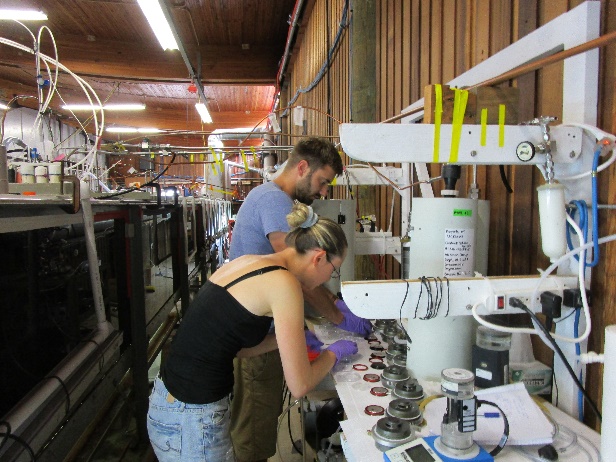Dozens of instruments from many universities, this is what it takes to do real science! Nowadays, great discoveries are not possible within one laboratory working in isolation. Collaborations of research teams that have various techniques, approaches, and backgrounds from multiple scientific disciplines are necessary for innovations and advances. This summer professors, graduate and undergraduate students from all over the country came to Scripps Institution of Oceanography at University of California, San Diego to participate in 2014 NSF Center for Aerosol Impacts on Climate and the Environment (CAICE) IMPACTS (Investigation into Marine PArticle Chemistry and Transfer Science) campaign.
I came from the University of Iowa where I just started my fifth year of graduate school in Dr. Vicki Grassian research group. My area of interest is phase, composition and hygroscopicity of individual sea spray aerosol particles. We collect particles generated during wave breaking and then take them back to Iowa for detailed micro-structural analysis with a variety of microscopic and spectroscopic techniques. Atomic force microscopy is a tool to image the surface of particles at the nanoscale and it is exceptionally noteworthy that it can reveal 3D shape of particles. Scanning electron microscopy and transmission electron microscopy can image particles down to 1 nm resolution and when used with energy-dispersive X-ray spectroscopy can reveal spatial elemental composition of particles. Raman microspectroscopy gives information about vibrations of functional groups thus revealing chemical composition of particles as small as several hundred nanometers. Elemental and molecular composition derived from these techniques can be combined with on-line measurements such as aerosol time-of-flight mass spectrometry to get the most complete information about particles’ composition. All microscopy techniques can be performed in chambers where relative humidity is be controlled and size of particles is monitored using microscope. Therefore, we can detect how particles grow in humid environment. Raman microspectrometer can detect the water in particles spectroscopically and thus can be additionally used to monitor water content of particles as relative humidity changes. It is very important to know how particles interact with water as it determines how particles will interact with light, form clouds and react with trace gases in the atmosphere (which can be fairly humid). Finally, as we learn about the dependence of particles’ properties on their detailed chemical composition we can understand and more importantly predict their properties in the environment better!
As I have already mentioned collaboration is a key for breakthrough research discoveries. Collaboration and teamwork! This picture illustrates teamwork in action where Jon and Olga (author) are putting together stages to collect sea spray aerosol particles. This is a great campaign that unites many research groups and I look forward to analyzing our particles and working with other participating groups to shade more light on marine atmosphere.
Olga Laskina, Research Assistant, Grassian Research Group, Department of Chemistry at University of Iowa


